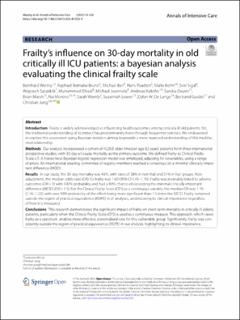| dc.description.abstract | Introduction
Frailty is widely acknowledged as influencing health outcomes among critically ill old patients. Yet, the traditional understanding of its impact has predominantly been through frequentist statistics. We endeavored to explore this association using Bayesian statistics aiming to provide a more nuanced understanding of this multifaceted relationship.
Methods
Our analysis incorporated a cohort of 10,363 older (median age 82 years) patients from three international prospective studies, with 30-day all-cause mortality as the primary outcome. We defined frailty as Clinical Frailty Scale ≥ 5. A hierarchical Bayesian logistic regression model was employed, adjusting for covariables, using a range of priors. An international steering committee of registry members reached a consensus on a minimal clinically important difference (MCID).
Results
In our study, the 30-day mortality was 43%, with rates of 38% in non-frail and 51% in frail groups. Post-adjustment, the median odds ratio (OR) for frailty was 1.60 (95% CI 1.45–1.76). Frailty was invariably linked to adverse outcomes (OR > 1) with 100% probability and had a 90% chance of exceeding the minimal clinically important difference (MCID) (OR > 1.5). For the Clinical Frailty Scale (CFS) as a continuous variable, the median OR was 1.19 (1.16–1.22), with over 99% probability of the effect being more significant than 1.5 times the MCID. Frailty remained outside the region of practical equivalence (ROPE) in all analyses, underscoring its clinical importance regardless of how it is measured.
Conclusions
This research demonstrates the significant impact of frailty on short-term mortality in critically ill elderly patients, particularly when the Clinical Frailty Scale (CFS) is used as a continuous measure. This approach, which views frailty as a spectrum, enables more effective, personalized care for this vulnerable group. Significantly, frailty was consistently outside the region of practical equivalence (ROPE) in our analysis, highlighting its clinical importance. | en_US |

